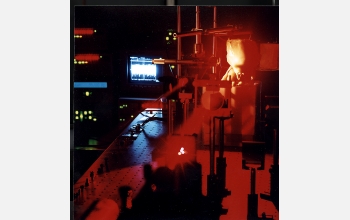Multimedia Gallery
Developing non-invasive detection for cancer
Researchers at the Optical Imaging Laboratory, part of the biomedical engineering program in Texas A&M University's Industrial Engineering Department, work on developing a non-invasive early detection procedure for cancerous tissue.
The new technique, called ultrasound-modulated laser tomography, produces a 3-D image similar to a CT scan. It can locate tumors buried up to 4 inches under the skin's surface. Cancerous tissue deflects and absorbs light differently than normal tissue. This light scattering makes it difficult to optically image tissue. To overcome the problem, researchers at the lab combined ultrasound with low-powered lasers.
Current research at the lab involves measuring changes in the optical properties of simulated tissue samples. The researchers hope to apply these results to real-world problems in diagnosis and monitoring, beginning with breast cancer detection.
This research was supported by a grant from the National Science Foundation's Faculty Early Career Development (CAREER) program (grant BES 97-34491). (Year of image: 1998)
Credit: Texas A&M University
Images and other media in the National Science Foundation Multimedia Gallery are available for use in print and electronic material by NSF employees, members of the media, university staff, teachers and the general public. All media in the gallery are intended for personal, educational and nonprofit/non-commercial use only.
Images credited to the National Science Foundation, a federal agency, are in the public domain. The images were created by employees of the United States Government as part of their official duties or prepared by contractors as "works for hire" for NSF. You may freely use NSF-credited images and, at your discretion, credit NSF with a "Courtesy: National Science Foundation" notation.
Additional information about general usage can be found in Conditions.
Also Available:
Download the high-resolution TIFF version of the image. (6.6 MB)
Use your mouse to right-click (Mac users may need to Ctrl-click) the link above and choose the option that will save the file or target to your computer.

